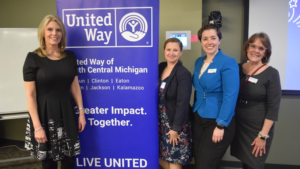This is part of a series of blogs spotlighting the ALICE population and how our community can make a difference.
People who are Asset Limited, Income Constrained and Employed (ALICE) make up 40% of Michigan’s population. Here’s what the 2019 ALICE Report revealed about these individuals and families:
“Despite overall improvement in employment and gains in median income, the economic recovery in Michigan has been uneven. Many ALICE households continue to face challenges from low wages, reduced work hours, depleted savings and increasing costs. For the many households that earned slightly above the ALICE Threshold in the past, increases in the cost of living and flat wages have pushed them below the Threshold and into financial hardship. The total number of Michigan households that cannot afford basic needs increased 6 percent from 2010 to 2017.
“This Report focuses on trends that have moved more Michigan families below the ALICE Threshold. Key findings include:
- Households continue to struggle: Of Michigan’s 3,935,132 households, 14 percent lived in poverty in 2017 and another 29 percent were ALICE. Combined, 43 percent (1,664,606 households) had income below the ALICE Threshold.
- Basic cost of living still on the rise: The cost of basic household expenses in the ALICE Household Survival Budget has increased steadily in Michigan, to $61,272 for a family of four (two adults with one infant and one preschooler) and $21,036 for a single adult. These bare-minimum budgets are significantly higher than the 2017 FPL of $24,600 for a family of four and $12,060 for a single adult. The cost of the average Michigan family budget increased by 27 percent from 2010 to 2017.
- Changes in the workforce: Although unemployment rates are falling, ALICE workers are still struggling. Low-wage jobs dominate the employment landscape, with 61 percent of all jobs in Michigan paying less than $20 per hour. At the same time, an increase in contract and on-demand jobs is leading to less financial stability. Gaps in wages are growing wider and vary depending on the size and location of employers as well as the sex, gender, education, sexual orientation, and race/ethnicity of workers.
- Emerging trends: Several trends could impact the economic landscape for ALICE families:
- The changing American household — Baby boomers are aging, millennials are making different lifestyle and work choices than previous generations, and patterns of domestic and foreign migration are shifting. These trends are changing both household composition and demands for goods and services.
- Market instability — A globally connected economy means that economic disruptions and natural disasters in one part of the world will increasingly have an impact on U.S. ALICE workers, contributing to employment instability, a shifting supply and demand, and a disruption in traditional modes of operation.
- Health inequality — As health care costs rise, there will be increasing disparities in health according to income and other social determinants of health, such as access to health care, educational opportunities, and safe neighborhoods. Expensive medical advances that are out of reach of lower-income households will only further this divide.”










